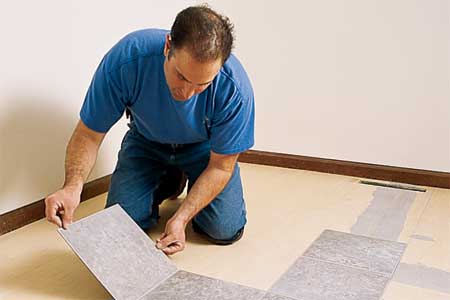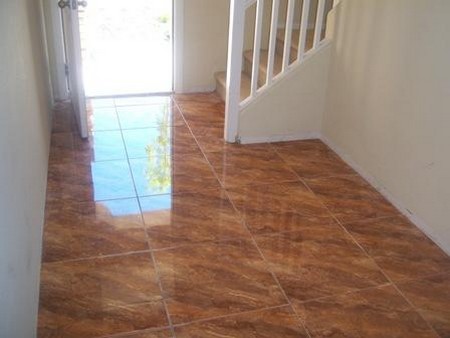The first vinyl-type floor tiles I ever laid were for my mum in our kitchen-cum-dining room – that was thirty years ago! I can hear you all saying ‘How could he possibly have done that job at the age of five!’ Thank you all for that gesture, it was so kind. And I wasn’t a day over seven!
Seriously though, I was just fifteen, and these tiles weren’t so much vinyl, more linoleum tiles, with a hessian backing. They were also as tough as old boots!
The floorboards were all over the place, so I had to pin down some sheeting to level up the floor. I pinned down some hardboard with small ring nails. It looked very good -tight joints, and nice and flat as well. The tiles were so thick and hard that I couldn’t stick them down – I had a serious problem. Mum was out, and the adhesive on the floor would be going off soon, so I needed a quick fix. I put the tiles in mum’s new cooker oven. After a while, a strange smell started to permeate through the ground floor just as Mum was returning, so I quickly opened the oven to grab the tiles but they were so hot that I burnt my hands and dropped them; half in the oven and half out. I was hopping around the kitchen blowing on my hands and Mum was chasing me around trying to whack me over the head for ruining her new cooker. To this day she still can’t fathom out why I wanted to grill the tiles.
I have to admit, apart from what you’ve read here, the tiles were not particularly successful once they were laid in position. Being very brittle, they seemed to damage far too easily. This probably wasn’t helped by the fact that I hadn’t soaked the hardboard before I laid it, creating a rolling landscape out of the kitchen floor. This was definitely something that Constable might have been proud of – it was a very arresting picture!
Fortunately, vinyl tiles are much easier to use than those I had to deal with all those years ago. In the case of a conventional boarded wooden floor, it is necessary to overlay the floor first either with hardboard or 6mm plywood. I prefer the plywood. It is not much more expensive than hardboard, but makes a better job. Fix the plywood or hardboard with 25mm (1in) ring nails.
Vinyl tiles are normally self-adhesive, but store the tiles in the room for a couple of days for them to acclimatize to the room temperature. Mark the center of two opposite walls and snap a chalk line or string between the two points. Repeat this on the opposite two walls and you’ll have a center point. Lay out some tiles at this point, without removing the protective backing, to see the most effective way of fixing them with minimum wastage and balanced cut edges.
Mark your starting position. Lift the tiles and give the floor a final vacuum. Peel the backing off the first tile and carefully place to the marks applying smoothing pressure with your hands. Repeat the process, concentrating on one half of the floor and steadily laying a pyramid shape, carefully butting the tiles together.
For trimming in the edges, lay a tile against the wall over the last full tile (without removing the backing) and mark the fixed tile. Transfer the marks onto a tile for cutting with a sharp craft knife and straight edge. Peel the back off and stick the cut tile firmly into place. Now all you have to do is stand back and admire your work.
In a kitchen or bathroom, make sure that the floor and the bottoms of the surrounding walls are absolutely dry and clean before you begin laying the tiles.
Categories
Advertisements
Recent Articles
 How to Understand Bed Sizes – A Small Guide
How to Understand Bed Sizes – A Small Guide How to Select Some Must Have Kitchen Accessories
How to Select Some Must Have Kitchen Accessories Best Way to Change a Car Tire
Best Way to Change a Car Tire Best Way to Write an Affirmation
Best Way to Write an Affirmation Best Way to Take Charge of Your Financial Life
Best Way to Take Charge of Your Financial Life Best Way to Survive a Party When You Don’t Know Anyone
Best Way to Survive a Party When You Don’t Know Anyone Best Way to Stop Self Sabotaging Yourself
Best Way to Stop Self Sabotaging Yourself Best Way to Start Journal Writing
Best Way to Start Journal Writing Best Way to Speak with a Powerful Voice
Best Way to Speak with a Powerful Voice Best Way to Simplify Your Life
Best Way to Simplify Your Life Best Way to Respond to a Put-Down
Best Way to Respond to a Put-Down Best Way to Reduce Acne Breakouts
Best Way to Reduce Acne Breakouts Best Way to Recover from Dining Disasters
Best Way to Recover from Dining Disasters Best Way to Quit Your Job Gracefully
Best Way to Quit Your Job Gracefully Best Way to Make Your Own Website
Best Way to Make Your Own Website



Leave a Reply